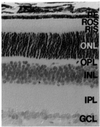On the genetics of retinitis pigmentosa and on mutation-independent approaches to therapeutic intervention
- PMID: 11867514
- PMCID: PMC125887
- DOI: 10.1093/emboj/21.5.857
On the genetics of retinitis pigmentosa and on mutation-independent approaches to therapeutic intervention
Abstract
Retinitis pigmentosa (RP), the group of hereditary conditions involving death of retinal photoreceptors, represents the most prevalent cause of visual handicap among working populations in developed countries. Here we provide an overview of the molecular pathologies associated with such disorders, from which it becomes clearly apparent that RP is one of the most genetically heterogeneous of hereditary conditions for which molecular pathologies have so far been elucidated. While heterogeneity of such magnitude would appear to represent a major impediment to the development of therapeutics, mutation-independent approaches to therapy are being developed to effectively by-pass such diversity in genetic aetiology. The implications of such technologies in terms of therapeutic intervention in RP, and indeed other genetically heterogeneous conditions, will be addressed.
Figures





References
-
- Acland G.M. et al. (2001) Gene therapy restores vision in a canine model of childhood blindness. Nature Genet., 28, 92–95. - PubMed
-
- Akimoto M., Miyatake,S.-I., Kogishi,J.-I., Hangai,M., Okazaki,K., Takahashi,J.C., Saiki,M., Iwaki,M. and Honda,Y. (1999) Adenovirally expressed basic fibroblast growth factor rescues photoreceptor cells in RCS rats. Invest. Ophthalmol. Vis. Sci., 40, 273–279. - PubMed
-
- Ali R.R. et al. (2000) Restoration of photoreceptor ultrastructure and function in retinal degeneration slow mice by gene therapy. Nature Genet., 25, 306–310. - PubMed
-
- Banerjee P. et al. (1998) TULP1 mutation in two extended Dominican kindreds with autosomal recessive retinitis pigmentosa. Nature Genet., 18, 177–179. - PubMed
Publication types
MeSH terms
Substances
LinkOut - more resources
Full Text Sources
Other Literature Sources

